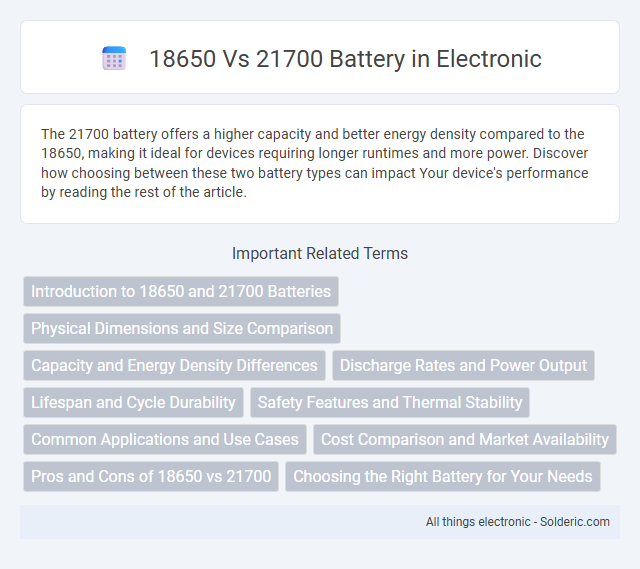The 21700 battery offers a higher capacity and better energy density compared to the 18650, making it ideal for devices requiring longer runtimes and more power. Discover how choosing between these two battery types can impact Your device's performance by reading the rest of the article.
Comparison Table
| Feature | 18650 Battery | 21700 Battery |
|---|---|---|
| Dimensions | 18mm diameter, 65mm length | 21mm diameter, 70mm length |
| Capacity | 1800-3500 mAh | 4000-5000 mAh |
| Energy Density | 200-260 Wh/kg | 250-300 Wh/kg |
| Discharge Rate | 5-30A (varies by model) | 10-35A (varies by model) |
| Applications | Laptops, flashlights, e-cigarettes | Electric vehicles, power tools, high-performance devices |
| Weight | 40-50 grams | 60-70 grams |
| Cycle Life | 300-500 charge cycles | 500-1000 charge cycles |
Introduction to 18650 and 21700 Batteries
18650 and 21700 batteries are cylindrical lithium-ion rechargeable cells widely used in various electronic devices and electric vehicles. The 18650 battery measures 18mm in diameter and 65mm in length, while the 21700 battery is larger with a diameter of 21mm and length of 70mm, allowing it to store more energy and deliver higher power output. Both battery types offer high energy density and long cycle life, but the 21700 model is often preferred for advanced applications requiring greater capacity and efficiency.
Physical Dimensions and Size Comparison
The 18650 and 21700 batteries differ significantly in physical dimensions, with the 18650 measuring 18mm in diameter and 65mm in length, while the 21700 is larger at 21mm in diameter and 70mm in length. This size increase in the 21700 battery allows for higher capacity and improved energy density, making it suitable for applications requiring longer runtime. Your choice between these batteries depends on the device compatibility and the desired balance of power and size.
Capacity and Energy Density Differences
The 21700 battery typically offers higher capacity ranging from 4000mAh to 5000mAh compared to the 18650 battery's 1800mAh to 3500mAh, resulting in longer usage times for devices. Energy density in 21700 cells is generally superior due to their larger volume, allowing more active material and improved power delivery without significantly increasing weight. Your choice between these batteries will impact runtime and efficiency, with 21700 batteries favored in high-performance applications requiring extended power output.
Discharge Rates and Power Output
18650 batteries typically offer discharge rates around 10-20 amps, making them suitable for moderate power applications, while 21700 batteries often support higher discharge rates up to 30 amps or more, providing enhanced power output and efficiency. The larger capacity and improved thermal management of 21700 cells enable longer run times and more consistent voltage under load compared to 18650 cells. Selecting the right battery depends on your device's power demands, with 21700 models better suited for high-drain applications requiring sustained performance.
Lifespan and Cycle Durability
The 21700 battery generally offers a longer lifespan and higher cycle durability compared to the 18650, with typical cycle counts ranging from 400 to 600 versus 300 to 500 for 18650 cells. Advanced lithium-ion chemistries used in 21700 cells contribute to improved charge retention and thermal stability, enhancing overall durability. These factors make 21700 batteries better suited for high-drain devices and applications demanding longer operational life.
Safety Features and Thermal Stability
The 21700 battery typically offers enhanced safety features and superior thermal stability compared to the 18650 due to its larger size, allowing for better heat dissipation and more robust internal structure. Advanced protective circuits and higher-quality electrolyte materials in 21700 cells further reduce the risk of overheating, short circuits, and thermal runaway. These improvements make 21700 batteries safer choices for high-drain applications such as electric vehicles and power tools.
Common Applications and Use Cases
18650 batteries are commonly used in laptops, flashlights, and electric bicycles due to their compact size and reliable capacity ranging from 1800mAh to 3500mAh. 21700 batteries, with higher energy density and capacities up to 5000mAh, are preferred in electric vehicles, power tools, and high-performance vaping devices. Both battery types are integral to portable electronics and energy storage solutions, but 21700 cells offer enhanced power output and longer runtime for demanding applications.
Cost Comparison and Market Availability
The 18650 battery remains more affordable and widely available due to its established manufacturing processes and higher production volumes. The 21700 battery, while offering superior energy density and capacity, typically commands a higher price reflecting newer technology and growing but still expanding market presence. Market trends indicate that as demand for higher performance applications increases, 21700 batteries are becoming more accessible, narrowing the cost gap with 18650 cells.
Pros and Cons of 18650 vs 21700
The 18650 battery offers a compact size and widespread availability, making it ideal for smaller devices and applications requiring lightweight power sources; however, it generally has a lower capacity, around 2500-3500mAh, and delivers less runtime compared to the larger 21700 cells. The 21700 battery features higher capacity ranges of 4000-5000mAh and improved energy density, which translates into longer usage times and greater power output, but its larger size may limit compatibility with devices designed for 18650 cells. While 18650 batteries benefit from extensive market presence and affordability, 21700 cells are favored in high-drain applications such as electric vehicles and power tools due to enhanced performance and thermal management.
Choosing the Right Battery for Your Needs
Choosing between a 18650 and 21700 battery depends on your device's power requirements and usage duration. The 21700 offers higher capacity and longer run time, making it ideal for high-drain devices or extended use, while the 18650 is more compact and suitable for smaller gadgets. Assess your device's size constraints and power demands to select the battery that best aligns with your performance needs.
18650 vs 21700 battery Infographic

 solderic.com
solderic.com